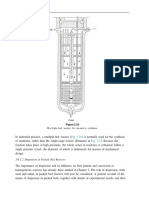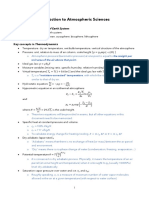Lecture 12
Lecture 12
Uploaded by
atowarCopyright:
Available Formats
Lecture 12
Lecture 12
Uploaded by
atowarCopyright
Available Formats
Share this document
Did you find this document useful?
Is this content inappropriate?
Copyright:
Available Formats
Lecture 12
Lecture 12
Uploaded by
atowarCopyright:
Available Formats
Lecture 12: Heterogeneous Nucleation: a surface catalyzed process
Todays topics What is heterogeneous nucleation? What implied in real practice of materials processing and phase transformation? Heterogeneous nucleation can be considered as a surface catalyzed or assisted nucleation process. The extent of how a surface can catalyze or facilitate the nucleation depends on the contact angle of the nucleus with respect to the substrate. The smaller the angle (or the stronger the wetting of the surface), the lower the free energy change, and the lower the nucleation barrier will be. Critical radius of the nucleus (r*) for a heterogeneous nucleation is the same as that for a homogeneous nucleation, whereas the critical volume of the nucleus (like the droplet for liquid nucleated from gas/vapor phase) is usually smaller for heterogeneous nucleation than for homogeneous nucleation, due to the surface wetting (spreading).
About Heterogeneous Nucleation Heterogeneous nucleation occurs much more often than homogeneous nucleation. Heterogeneous nucleation applies to the phase transformation between any two phases of gas, liquid, or solid, typically for example, condensation of gas/vapor, solidification from liquid, bubble formation from liquid, etc. Heterogeneous nucleation forms at preferential sites such as phase boundaries, surfaces (of container, bottles, etc.) or impurities like dust. At such preferential sites, the effective surface energy is lower, thus diminishes the free energy barrier and facilitating nucleation. Surfaces promote nucleation because of wetting contact angles greater than zero between phases facilitate particles to nucleate. The free energy needed for heterogeneous nucleation is equal to the product of homogeneous nucleation and a function of the contact angle :
where
f() =
2 3 cos + cos3 4
The barrier energy needed for heterogeneous nucleation is reduced (see the plot below), and less supercooling is needed. The wetting angle determines the ease of nucleation by reducing the energy needed.
G*hom
G*het
r0
Radius (r)
Some examples of heterogeneous nucleation include: 1) adding ice powders into supercooled water speeds up the freezing process as you saw from the movie clip attached to Lecture 10. 2) Bubbles of carbon dioxide nucleate shortly on the inner surface of a container after it is gently opened (as the pressure is released). Since the surface is smooth and flat (specific surface area is small), bubble formation on such surface is usually slow as you often see in life. 3) putting a finger into the carbonated water usually facilitates the bubble formation as you see from the picture below, because finger surface (more rough compared to the glass or plastic substrate) provides much larger surface area. 4) putting a chalk (with even larger surface area due to the porous structure) leads to much faster formation (nucleation) of bubbles from the carbonated water just as you can see from the movie clip attached to this Lecture, http://www.eng.utah.edu/~lzang/images/bubble.wmv --- have fun!
Nucleation of carbon dioxide bubbles around a finger
A droplet of liquid on a flat solid surface takes the shape of a truncated sphere. The surface must be spherical since a liquid does not support a shear stress and is isotropic. Gas phase - Liquid - (locally) flat solid surface, e.g., container wall - There are three different surface energies of interest: = (gas - liquid) = (gas - solid) = (liquid - solid)
Assume we know all three surface energies, the object is to determine , the contact angle. One way is to use force balance approach to determine . cos + = which gives cos=
This derivation is not very satisfactory because the vertical component is not balanced. Given time this force would pull the substrate upward until the surface tension forces balance in all directions. Therefore, derivation of the above equation is based on an assumption that substrate is infinitely rigid, remaining planar. Though such an assumption is usually reasonable, we can still deduce the above equation through a more accurate way as described below. A more accurate approach through minimization of free energy: Consider a droplet of liquid on a flat surface with fixed volume. The total surface energy of the system is a function of the shape of the droplet. The left shows two different shapes of the same volume, but of different surface area > leading to different Surface energy: Gs = A + A + A where A, A and A are areas of , and interfaces, respectively. Assume r be the radius of curvature of the droplet, then: A = r2 sin2 A = A0 - r2 sin2; A0 is the area of interface without A =
(2r sin )(rd ) = 2r 2 (1 cos )
Thus, Gs = GS(r,) = 2r 2 (1 cos ) + (A0- r2 sin2) + r2 sin2
At equilibrium, dGS = (
G GS ) dr + ( S ) r d = 0 r
then, dGS = {4 r (1-cos) + 2 r ( - ) sin2} d r + {2 r2 sin + 2 r2 ( - ) sin cos}d = 0 Volume of , V, can be obtained as,
V =
r3 ( r 2 sin 2 )(rd sin ) = sin 3 d =
0
r 3
3
[2 3 cos + cos3 ]
Since volume of remains fixed, d V = 0 = ( then, we have dr =
V V ) dr + ( ) r d r
r sin (1 + cos ) d (2 cos cos 2 )
replacing >, then we have, cos=
(3)
Now lets derive the heterogeneous nucleation energy and critical size: Assume nucleus to be spherical with radius r, the free energy change for the nucleation is G(r) = VGV +A + ( -) A = (two contributions: volumetric free energy + surface energy)
r3
3
[2 3cos + cos3 ]GV + 2 r 2 [1 cos ] + ( ) r 2 sin 2
( ) = cos , replacing this into above equation, then we have
From Eq. (3), we have
G(r) =
r3
3
GV [2 3cos + cos3 ] + 2 r 2 [1 cos ] r 2 cos sin 2
(note: sin = 1 cos )
2 2
=[
4 3 2 3 cos + cos3 ] r GV + 4 r 2 ] . [ 4 3
Note the first term in parenthesis is the G(r) for homogenous nucleation. Then we can re-write Ghet(r) = Ghom(r) f() where f() = 0 f() 1.0 for for =1800, f() = 1 no wetting of the surface, and thus no catalysis by the surface --- falling into the case of homogeneous nucleation. 0 =0 , f() = 0 full wetting, fully catalyzed, no barrier for nucleation at surface.
2 3 cos + cos3 4
The G(r) must go through a maximum, where
dG (r ) = 0 , then, dr
dG (r ) = 0 = 4r 2 GV + 8r dr r *
Then we have the critical radius, r* = -
2 GV
It is important to note that the critical radius r* remains unchanged for heterogeneous nucleation and homogeneous nucleation. However, the volume (V) can be significantly less for heterogeneous nucleation due to the wetting angle affecting the shape of the nucleus.
V (het) =
r3
3
[2 3cos + cos3 ] = V (hom) f()
We also have
16 3 4 3 2 G* =G(r*) = [ . f() r * GV + 4 r * ] . f() = 3 3GV 2
--- nucleation barrier can be
significantly lower for heterogeneous nucleation due to wetting angle affecting the shape of the nucleus.
G*hom G G*het r*
r* r* homo hetero
Note: The above addressed nucleation is for gas-to-liquid nucleation. The similar theoretical treatment is also applied to the liquid-to-solid nucleation.
You might also like
- Feld & Basso - Senses of PlaceDocument151 pagesFeld & Basso - Senses of PlaceJamMarmaladeJam94% (17)
- Ayurveda A Little Book of Self CareDocument144 pagesAyurveda A Little Book of Self CareDavid Santos90% (10)
- Engineering Workshop Report 1Document16 pagesEngineering Workshop Report 1Hanzzel Charles80% (5)
- Termodinamica de Superficies 1Document44 pagesTermodinamica de Superficies 1Monica Chipana MarcasNo ratings yet
- Colloid and Interfacial Engineering Slides Part 02Document53 pagesColloid and Interfacial Engineering Slides Part 02Nalini Kumar Mandal100% (1)
- Evaporationwater v5 JensDocument14 pagesEvaporationwater v5 Jensroushan05251990No ratings yet
- Wetting: Gibbs' Superficial Tension Revisited: Borislav V. Toshev, Dimo PlatikanovDocument4 pagesWetting: Gibbs' Superficial Tension Revisited: Borislav V. Toshev, Dimo PlatikanovAbraham Ruiz RodriguezNo ratings yet
- Homogeneous NucleationDocument18 pagesHomogeneous NucleationPrimawati RahmaniyahNo ratings yet
- Applications of Divergence (Mini Project)Document23 pagesApplications of Divergence (Mini Project)BhargavVuppalapati67% (6)
- Chap 9 SurfacethermoDocument39 pagesChap 9 SurfacethermoJavier Vallejo MontesinosNo ratings yet
- Electric FluxDocument21 pagesElectric FluxMaxNo ratings yet
- Lionel Levine and Yuval Peres - Strong Spherical Asymptotics For Rotor-Router Aggregation and The Divisible SandpileDocument33 pagesLionel Levine and Yuval Peres - Strong Spherical Asymptotics For Rotor-Router Aggregation and The Divisible SandpileHemAO1No ratings yet
- Laverne J Et AlDocument9 pagesLaverne J Et AlAldyansyah PutraNo ratings yet
- Fluids - Lecture 1 Notes: Formation of Lifting FlowDocument78 pagesFluids - Lecture 1 Notes: Formation of Lifting FlowjavierzmorNo ratings yet
- ENME 332, Spring 2013 Transfer Processes: Instructors: Reinhard Radermacher & Bao YangDocument18 pagesENME 332, Spring 2013 Transfer Processes: Instructors: Reinhard Radermacher & Bao YangZain BaqarNo ratings yet
- Chapter 9Document24 pagesChapter 9mxjoeNo ratings yet
- Lab 9 ViscosityDocument6 pagesLab 9 Viscosityhrybtmhmd031No ratings yet
- Outline: Energy Transport: Radiative Equilibrium and ConvectionDocument27 pagesOutline: Energy Transport: Radiative Equilibrium and ConvectionAndie AcostaNo ratings yet
- Hristu Culetu - Light Dragging Phenomenon and Expanding WormholesDocument11 pagesHristu Culetu - Light Dragging Phenomenon and Expanding WormholesCoy668No ratings yet
- 2 Surface Thermodynamics 2012Document41 pages2 Surface Thermodynamics 2012Mubdiana ArifinNo ratings yet
- HW4-Wetting Exercise 1.: Solid LiquidDocument6 pagesHW4-Wetting Exercise 1.: Solid LiquidHoNo ratings yet
- Steady Steam Condensation On An Extended Surface With Suction of CondensateDocument24 pagesSteady Steam Condensation On An Extended Surface With Suction of Condensatealentan_774042No ratings yet
- Holton ErrataDocument2 pagesHolton ErrataSenju HerkNo ratings yet
- Computation of Added Mass and Damping Coefficients Due To A Heaving CylinderDocument14 pagesComputation of Added Mass and Damping Coefficients Due To A Heaving CylinderlapuNo ratings yet
- Boundary Transitions.Document11 pagesBoundary Transitions.Angela MatamorosNo ratings yet
- Heterogeneous NucleationDocument4 pagesHeterogeneous NucleationDimpy KhatriNo ratings yet
- Teoria Cuantica de Campos en Espacio Tiempo CurvoDocument13 pagesTeoria Cuantica de Campos en Espacio Tiempo CurvopveNo ratings yet
- Fin 00142Document10 pagesFin 00142Alfredo landaverde GarciaNo ratings yet
- Simultaneous Estimation of The Refractive Index and Thickness of Marine Oil Slick From The Degree of Linear Polarization of The Sun-Glint ReflectionDocument10 pagesSimultaneous Estimation of The Refractive Index and Thickness of Marine Oil Slick From The Degree of Linear Polarization of The Sun-Glint ReflectionJoão JúniorNo ratings yet
- Pii - 0379-6787 (84) 90017-6Document11 pagesPii - 0379-6787 (84) 90017-6stuff93No ratings yet
- II.3 System of Equations of The Gravitational Field and Upward ContinuationDocument7 pagesII.3 System of Equations of The Gravitational Field and Upward ContinuationlulaNo ratings yet
- Dispersion: M U Lti Ple-Bed Reactor For Am Mon Ia SynthesisDocument11 pagesDispersion: M U Lti Ple-Bed Reactor For Am Mon Ia SynthesisCesar ZacNo ratings yet
- 3D Numerical Investigation of Forces and Flow FielDocument21 pages3D Numerical Investigation of Forces and Flow FielAhmed DarwishNo ratings yet
- Steady Flow Along A Rankine Half-BodyDocument7 pagesSteady Flow Along A Rankine Half-BodyTubaguts1234No ratings yet
- Lecture5 14Document60 pagesLecture5 14Elan YogeswarenNo ratings yet
- Hydrodynamic ForcesDocument11 pagesHydrodynamic ForcesGraham SeggewissNo ratings yet
- Ocean Surface Gravity WavesDocument13 pagesOcean Surface Gravity WavesVivek ReddyNo ratings yet
- Jose P. S. Lemos and Francisco S. N. Lobo - Plane Symmetric Traversable Wormholes in An Anti-De Sitter BackgroundDocument14 pagesJose P. S. Lemos and Francisco S. N. Lobo - Plane Symmetric Traversable Wormholes in An Anti-De Sitter BackgroundRtpomNo ratings yet
- Iwwwfb39 21Document4 pagesIwwwfb39 21Maxime BrudoNo ratings yet
- Ref Phy 18Document1,245 pagesRef Phy 18mkumar0% (1)
- QTTBDocument4 pagesQTTBvy.nguyenvyNo ratings yet
- Pertemuan - 08 Dynamics 3Document32 pagesPertemuan - 08 Dynamics 3Niken SyuaibNo ratings yet
- External Flow Over Bluff Objects and Impining JetsDocument14 pagesExternal Flow Over Bluff Objects and Impining JetsAladdin AntarNo ratings yet
- Large-Small Equivalence in String TheoryDocument12 pagesLarge-Small Equivalence in String Theorywalter huNo ratings yet
- Thermodynamics III: 1 Surface TensionDocument20 pagesThermodynamics III: 1 Surface Tension66 SB jay gotiNo ratings yet
- Physics 210A: Statistical Physics HW Assignment #4 SolutionsDocument7 pagesPhysics 210A: Statistical Physics HW Assignment #4 SolutionsGhadendra BhandariNo ratings yet
- Schofield Et Al JEM 2020Document22 pagesSchofield Et Al JEM 2020vpcNo ratings yet
- Introduction To Atmospheric Science - Key Concepts Long VersionDocument7 pagesIntroduction To Atmospheric Science - Key Concepts Long VersionC LH BrianNo ratings yet
- A Numerical Model For Nearshore Wave Propagation Based On The Time Dependent Mild Slope EquationDocument15 pagesA Numerical Model For Nearshore Wave Propagation Based On The Time Dependent Mild Slope Equationsoumya1986No ratings yet
- Chapter 09 AdsorptionDocument27 pagesChapter 09 AdsorptionYuppie RajNo ratings yet
- Indian Association of Physics Teachers National Standard Examinations 2008 - 2009 Solutions / AnswersDocument7 pagesIndian Association of Physics Teachers National Standard Examinations 2008 - 2009 Solutions / AnswersKshitij SharmaNo ratings yet
- GFDL Barotropic Vorticity EqnsDocument12 pagesGFDL Barotropic Vorticity Eqnstoura8No ratings yet
- 2.7 Aerosols and Coagulation: 2.7.1 Brownian Diffusion of ParticlesDocument8 pages2.7 Aerosols and Coagulation: 2.7.1 Brownian Diffusion of ParticlesMJ SumalinogNo ratings yet
- حل امتحان بيئة اعمال سنة 2023Document4 pagesحل امتحان بيئة اعمال سنة 2023Ahmed MohsenNo ratings yet
- EE-311 Ch3 HW SolutionsDocument5 pagesEE-311 Ch3 HW Solutionsvimalk017No ratings yet
- Electric Flux and Flux Density, Gauss Law in Integral Form: Sections: 3.1, 3.2, 3.3 Homework: See Homework FileDocument21 pagesElectric Flux and Flux Density, Gauss Law in Integral Form: Sections: 3.1, 3.2, 3.3 Homework: See Homework FiletirmiziNo ratings yet
- Assignment - Solution 5Document9 pagesAssignment - Solution 5parmodrtkNo ratings yet
- SupplementaryMaterialSimulationsofProteinDocument3 pagesSupplementaryMaterialSimulationsofProteinRodrigo Toledo De AraujoNo ratings yet
- Two Types of Adsorption May Occur at The Gas-Solid InterfaceDocument18 pagesTwo Types of Adsorption May Occur at The Gas-Solid InterfaceEmile M. Al-MayahNo ratings yet
- Spectral CoreDocument19 pagesSpectral Core黃建成No ratings yet
- Phase Locked Loop Working and Operatin Principle With ApplicationsDocument5 pagesPhase Locked Loop Working and Operatin Principle With ApplicationsatowarNo ratings yet
- Phase Locked Loops, Block Diagram, Working, Operation, Design, ApplicationsDocument4 pagesPhase Locked Loops, Block Diagram, Working, Operation, Design, Applicationsatowar100% (1)
- T2 Skript CH 1corrDocument26 pagesT2 Skript CH 1corratowarNo ratings yet
- Experiments List - 1 2016Document1 pageExperiments List - 1 2016atowarNo ratings yet
- Effective Input Voltage: at T 0, VDocument6 pagesEffective Input Voltage: at T 0, VatowarNo ratings yet
- Phys 471 Session 4Document17 pagesPhys 471 Session 4atowarNo ratings yet
- King Notes Density of States 2D1D0D PDFDocument23 pagesKing Notes Density of States 2D1D0D PDFatowarNo ratings yet
- UPTU First Semester E&C Clipper, Clamper and Voltage MultiplierDocument20 pagesUPTU First Semester E&C Clipper, Clamper and Voltage MultiplieratowarNo ratings yet
- Chapter 9 Uniform Circular MotionDocument10 pagesChapter 9 Uniform Circular MotionZhu JiankunNo ratings yet
- 2Document11 pages2Sourabh porwalNo ratings yet
- Dosan LoaderDocument24 pagesDosan Loadercik cikNo ratings yet
- Radient's Updated Resume.Document3 pagesRadient's Updated Resume.Radient MushfikNo ratings yet
- VTU Nanotechnology SyllabusDocument45 pagesVTU Nanotechnology SyllabusSantosh MysoreNo ratings yet
- ACT Thrissur Plus Two Easy QuestionsDocument23 pagesACT Thrissur Plus Two Easy QuestionsAbin Pm100% (1)
- Final Exam - Arveena Arumugam ZP05616Document12 pagesFinal Exam - Arveena Arumugam ZP05616PRIYA REVIVAL0% (1)
- HFX 500P Rev 6 - 2018 PDFDocument2 pagesHFX 500P Rev 6 - 2018 PDFMuhammad Shabbir AwanNo ratings yet
- Instant Download Constructing Quantum Mechanics, Volume Two. The Arch: 1903 1927 1st Edition Anthony Duncan PDF All ChapterDocument64 pagesInstant Download Constructing Quantum Mechanics, Volume Two. The Arch: 1903 1927 1st Edition Anthony Duncan PDF All Chaptermralesmuld100% (4)
- I Am That I AmDocument9 pagesI Am That I AmAnairdaNo ratings yet
- OfertaDocument5 pagesOfertaoscarairesNo ratings yet
- Approximate Chap 5Document14 pagesApproximate Chap 5Risselle Bayore EdullantesNo ratings yet
- Lecture 02 MicrobiologyDocument4 pagesLecture 02 Microbiologymohamedlaissani209No ratings yet
- Operating Manual For Disc Brake Type SF 10-40Document42 pagesOperating Manual For Disc Brake Type SF 10-40Quốc Viêtj HuỳnhNo ratings yet
- 6-71-M74s0-D05a GPDocument94 pages6-71-M74s0-D05a GPmobaway2017No ratings yet
- Muffin AC - MU2A1 - 028021: (Family) (Model) (Part Number)Document3 pagesMuffin AC - MU2A1 - 028021: (Family) (Model) (Part Number)JuanVargasNo ratings yet
- GCE A Levels H2 Chemistry Prelim Paper 2 SolutionsDocument20 pagesGCE A Levels H2 Chemistry Prelim Paper 2 SolutionsChong56No ratings yet
- Fluid Mechanics Mid ExamDocument5 pagesFluid Mechanics Mid ExamRalph CastilloNo ratings yet
- HP Lubes GuideDocument196 pagesHP Lubes GuideJen Ekx100% (1)
- English Q1Document125 pagesEnglish Q1Glaudene Leonor RazonNo ratings yet
- Gadus S2 U460L 2Document2 pagesGadus S2 U460L 2FEBRIANSYAH NUSANTARANo ratings yet
- Manual Weather Station PCE-FWS-20: Date of Creation: 03.02.2016 Date of Last Change: 30.03.2016Document25 pagesManual Weather Station PCE-FWS-20: Date of Creation: 03.02.2016 Date of Last Change: 30.03.2016Jaime Alberto Parra PlazasNo ratings yet
- GHH Group Product Brochure LD ENDocument24 pagesGHH Group Product Brochure LD ENDino AlajbegovicNo ratings yet
- Evolution and Innovations in The Tolling Industry - Unveilled at GFF 2023Document19 pagesEvolution and Innovations in The Tolling Industry - Unveilled at GFF 2023Chintan Gandhi100% (1)
- Easec-15 Full Paper ScossaDocument8 pagesEasec-15 Full Paper ScossaManuelPérezNo ratings yet
- Aquaculture EngineeringDocument11 pagesAquaculture Engineeringshuvatheduva1231231230% (1)
- Inverter SK 2501 FCT PDFDocument64 pagesInverter SK 2501 FCT PDFRuslan RonskiyNo ratings yet

































































































